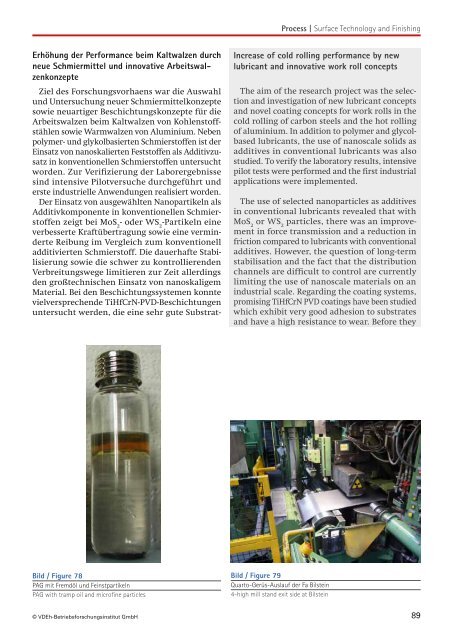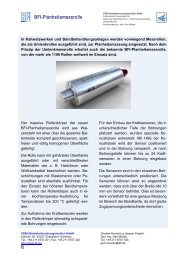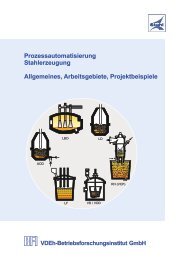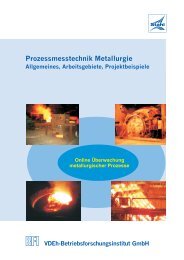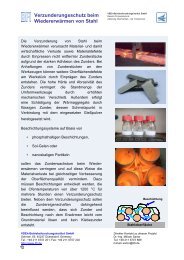Tätigkeitsbericht /Activity Report 2011/2012 - BFI.de
Tätigkeitsbericht /Activity Report 2011/2012 - BFI.de
Tätigkeitsbericht /Activity Report 2011/2012 - BFI.de
Erfolgreiche ePaper selbst erstellen
Machen Sie aus Ihren PDF Publikationen ein blätterbares Flipbook mit unserer einzigartigen Google optimierten e-Paper Software.
Process | Surface Technology and Finishing<br />
Erhöhung <strong>de</strong>r Performance beim Kaltwalzen durch<br />
neue Schmiermittel und innovative Arbeitswalzenkonzepte<br />
Ziel <strong>de</strong>s Forschungsvorhaens war die Auswahl<br />
und Untersuchung neuer Schmiermittelkonzepte<br />
sowie neuartiger Beschichtungskonzepte für die<br />
Arbeitswalzen beim Kaltwalzen von Kohlenstoffstählen<br />
sowie Warmwalzen von Aluminium. Neben<br />
polymer- und glykolbasierten Schmierstoffen ist <strong>de</strong>r<br />
Einsatz von nanoskalierten Feststoffen als Additivzusatz<br />
in konventionellen Schmierstoffen untersucht<br />
wor<strong>de</strong>n. Zur Verifizierung <strong>de</strong>r Laborergebnisse<br />
sind intensive Pilotversuche durchgeführt und<br />
erste industrielle Anwendungen realisiert wor<strong>de</strong>n.<br />
Der Einsatz von ausgewählten Nanopartikeln als<br />
Additivkomponente in konventionellen Schmierstoffen<br />
zeigt bei MoS 2<br />
- o<strong>de</strong>r WS 2<br />
-Partikeln eine<br />
verbesserte Kraftübertragung sowie eine vermin<strong>de</strong>rte<br />
Reibung im Vergleich zum konventionell<br />
additivierten Schmierstoff. Die dauerhafte Stabilisierung<br />
sowie die schwer zu kontrollieren<strong>de</strong>n<br />
Verbreitungswege limitieren zur Zeit allerdings<br />
<strong>de</strong>n großtechnischen Einsatz von nanoskaligem<br />
Material. Bei <strong>de</strong>n Beschichtungssystemen konnte<br />
vielversprechen<strong>de</strong> TiHfCrN-PVD-Beschichtungen<br />
untersucht wer<strong>de</strong>n, die eine sehr gute Substrat-<br />
Increase of cold rolling performance by new<br />
lubricant and innovative work roll concepts<br />
The aim of the research project was the selection<br />
and investigation of new lubricant concepts<br />
and novel coating concepts for work rolls in the<br />
cold rolling of carbon steels and the hot rolling<br />
of aluminium. In addition to polymer and glycolbased<br />
lubricants, the use of nanoscale solids as<br />
additives in conventional lubricants was also<br />
studied. To verify the laboratory results, intensive<br />
pilot tests were performed and the first industrial<br />
applications were implemented.<br />
The use of selected nanoparticles as additives<br />
in conventional lubricants revealed that with<br />
MoS 2<br />
or WS 2<br />
particles, there was an improvement<br />
in force transmission and a reduction in<br />
friction compared to lubricants with conventional<br />
additives. However, the question of long-term<br />
stabilisation and the fact that the distribution<br />
channels are difficult to control are currently<br />
limiting the use of nanoscale materials on an<br />
industrial scale. Regarding the coating systems,<br />
promising TiHfCrN PVD coatings have been studied<br />
which exhibit very good adhesion to substrates<br />
and have a high resistance to wear. Before they<br />
Bild / Figure 78<br />
PAG mit Fremdöl und Feinstpartikeln<br />
PAG with tramp oil and microfine particles<br />
© VDEh-Betriebsforschungsinstitut GmbH<br />
Bild / Figure 79<br />
Quarto-Gerüs-Auslauf <strong>de</strong>r Fa Bilstein<br />
4-high mill stand exit si<strong>de</strong> at Bilstein<br />
89


